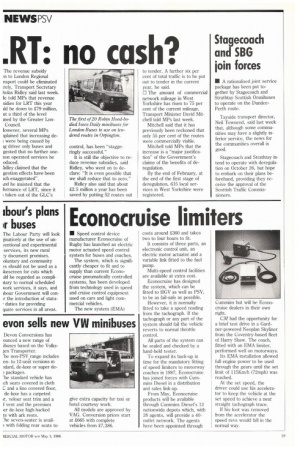Econocruise limiters
Page 19

If you've noticed an error in this article please click here to report it so we can fix it.
• Speed control device manufacturer Econocruise of Rugby has launched an electric motor actuated speed control system for buses and coaches.
The system, which is significantly cheaper to fit and to supply than current Econocruise pneumatically controlled systems, has been developed from technology used in speed and cruise control equipment used on cars and light commercial vehicles.
The new system (EMA) costs around .2360 and takes two to four hours to fit.
It consists of three parts, an electronic control unit, an electric motor actuator and a variable link fitted to the fuel pump.
Multi-speed control facilities are available at extra cost.
Econocruise has designed the system, which can be fitted to HGV as well as PSV, to be as fail-safe as possible.
However, it is normally fitted to take a speed reading from the tachograph. If the tachograph or any part of the system should fail the vehicle reverts to normal throttle control.
All parts of the system can be sealed and checked by a hand-held tester.
To expand its back-up in time for the mandatory fitting of speed limiters to motorway coaches in 1987, Econocruise has joined forces with Cummins Diesel in a distribution and sales link-up.
From May, Econocruise products will be available through Cummins Diesel's 12 nationwide depots which, with 28 agents, will provide a 40outlet network, The agents have been appointed through Cummins but will be Econocruise dealers in their own right.
CM had the opportunity for a brief test drive in a Gardner-powered Neoplan Skyliner from the Coventry-based fleet of Harry Shaw. The coach, fitted with an EMA limiter, performed well on motorways.
Its EMA installation allowed full engine power to be used through the gears until the set limit of 115Km/h (72mph) was reached.
At the set speed, the driver could use his accelerator to keep the vehicle at the set speed to achieve a near straight tachograph trace.
If his foot was removed from the accelerator the speed revs would fall in the normal way.






































































